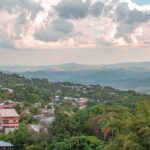Activity continues to bubble over in the world of landscape finance, with related fields such as place-based investment, conservation finance and systems-change finance, making it challenging to keep up with all of the most relevant reports and news. The 1000L Finance Solutions Design Team is working on system change, so we think it’s important to stay well-informed about the latest innovations and actors operating in the space. Our periodic finance-focused newsletter is a resource to help anyone interested in landscape finance gain more perspective on this ever-evolving field.
These are the landscape finance-related developments and reports that caught our eye in December 2021 and January 2022.
News & Developments
Local Climate Resilience Finance: How Can Mirage Become Reality?
This brief explores the need for integrated investments into risk assessment and adaptive resilience responses to reach the local level. Discussion covers the role of locally-organized savings and loan funds and the importance of strengthening indicators to track how much climate finance reaches local-level organizations. Published by the International Institute for Environment and Development.
Resilience+ Innovation Facility Targets Farmers in Sub-Saharan Africa and South Asia
The University of California at Davis announced the creation of the Resilience + Innovation Facility. This effort seeks to design and scale integrated approaches that strengthen farmers’ resilience to climate-related shocks. Funded by a $5 million, five-year grant from the Bill & Melinda Gates Foundation, the facility’s initial projects involve design and deployment of risk-management tools.
Examining the Costs and Benefits of Landscape Restoration
Co-authored by 1000L partner Commonland’s Simon Moolenaar, this 2022 academic paper presents a framework to analyze, quantify and capture the effects of changes in land use and management on the “true” costs and benefits. Results found that an integrated approach best assesses all functions of a sustainable land use system.
IDH Releases Initiative to Link Agricultural Companies and Local Stakeholders
IDH, The Sustainable Trade Initiative, introduced an online platform in late 2021 that links agricultural commodity companies with multi-stakeholder initiatives in producing regions. The platform, SourceUp, enables companies to access data from key supply regions to achieve more sustainable sourcing.
Neighborhood Green Bond Introduced
A UK neighborhood’s town council issued a small green bond that will fund electric vehicle charging stations and solar panels on public buildings and help develop a program for zero carbon recycling and waste collection. Issued by London’s Islington Council, the bond’s minimum investment is only 5 pounds and it pays fixed interest of 1.55% annually over a five-year term.
Driving Financing for Conservation in South Africa’s Critical Landscapes
The Sustainable Landscape Finance Coalition explains their approach to developing and implementing new finance solutions to different landscape contexts. The strategy consists of four stages, focusing on the initial finance building blocks and their strategic implementation.
Community Land Rights and Conservation Finance Initiative (CLARIFI)
The CLARIFI funding mechanism will help indigenous and other local community members tap into new and existing funding through targeted coordination and multi-level advocacy. Specifically, the capital generated by this initiative will help these stakeholders expand mapping of their lands, as well as create and implement plans to strengthen conservation, livelihoods and gender justice.
Q&A on Regenerative Agriculture and the Financial System
Three regenerative agriculture proponents engage in conversation with two bank directors about how to shift the focus of financing from short-term yields to long-term risks. The dialogue touches on the potential of this shift.
Australian Government Increases Investment to Reduce Pressures on Great Barrier Reef
The Australian government is investing more than $250 million into the Great Barrier Reef Marine Park Authority’s marine park management. The funding is part of the government’s total $3 billion funding for measures to protect the Great Barrier Reef. The investment includes funds for water quality initiatives, climate adaptation and resilience science, research and development, and community projects.
Ecotierra Funds Sustainable Local Coffee Production through Agroforestry
Ecotierra, through its Urapi Sustainable Land Use Fund, invested $8 million in a project in Colombia to restore land through sustainable coffee and cocoa agroforestry systems and honey production. The effort also includes carbon credit generation within a Verified Carbon Standard certified project. The investment will fund a processing mill, collection centers and a compost production plant, all of which should improve quality and traceability.
Reports
Collective Action: Corporate Engagement in Landscape and Jurisdictional Approaches
CDP, a non-profit that runs environmental impact disclosures for the corporate and government sectors , examines the status of corporate engagement with landscape and jurisdictional approaches (based on CDP’s 2020-21 data). The report shares lessons learned from collaborations with key partners and stakeholders. The report also focuses on the benefits of an integrated framework and collaboration among the multiple stakeholders in the landscape and offers recommendations for action.
Building Strong Places: A New, Impactful Role for Financial Institutions
This Impact Investing Institute report discusses how mainstream financial institutions can engage in place-based impact investing (PBII), with a focus on the UK economy. Among the recommendations for financial institutions are focusing on a few PBII relationships, which can lead to replicable models that can be expanded to other places; and creating financial models that can overcome barriers to reaching low income communities.
15 Funds That Could Transform Agriculture
The host of the popular podcast series Investing in Regenerative Agriculture identifies some of the fund managers that, in his view, show the most commitment and understanding. This blog post includes a descriptive spreadsheet comparing all 15 funds.
We hope you’ve found this newsletter helpful, and welcome your feedback.
We also invite you to share insightful reports and news developments as you come across them. Please reach out to dhecht@ecoagriculture.org


